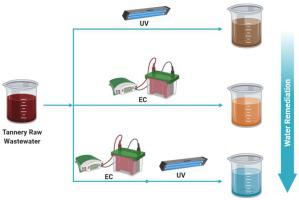Journal of Water Process Engineering ( IF 6.3 ) Pub Date : 2020-09-21 , DOI: 10.1016/j.jwpe.2020.101642 Sameh Jallouli , Ahmed Wali , Antonio Buonerba , Tiziano Zarra , Vincenzo Belgiorno , Vincenzo Naddeo , Mohamed Ksibi

|
Tannery wastewater contains large amounts of pollutants that, if directly discharged into ecosystems, can generate an environmental hazard. The present investigation has focused the attention to the remediation of wastewater originated from tanned leather in Tunisia. The analysis revealed wastewater with a high level of chemical oxygen demand (COD) of 7376 mgO2/L. The performance in reduction of COD, via electrocoagulation (EC) or UV photolysis or, finally, operating electrocoagulation and photolysis in sequence was examined. The effect of voltage and reaction time on COD reduction, as well as the phytotoxicity were determined. Treated effluents were analysed by UV spectroscopy, extracting the organic components with solvents differing in polarity. A sequential EC and UV treatment of the tannery wastewater has been proven effective in the reduction of COD. These treatments combined afforded 94.1 % of COD reduction, whereas the single EC and UV treatments afforded respectively 85.7 and 55.9 %. The final COD value of 428.7 mg/L was found largely below the limit of 1000 mg/L for admission of wastewater in public sewerage network. Germination tests of Hordeum Vulgare seeds indicated reduced toxicity for the remediated water. Energy consumptions of 33.33 kW h/m3 and 314.28 kW h/m3 were determined for the EC process and for the same followed by UV treatment. Both those technologies are yet available and ready for scale-up.
中文翻译:

连续电凝-紫外光解法高效,可持续地处理制革废水
制革废水包含大量污染物,如果直接排放到生态系统中,则会产生环境危害。目前的调查集中在突尼斯的鞣革废水处理方面。分析显示废水中的化学需氧量(COD)高,为7376 mg O2/升 检查了通过电凝(EC)或UV光解或最后依次进行电凝和光解可降低COD的性能。确定了电压和反应时间对COD还原的影响以及植物毒性。通过紫外线光谱分析处理过的废水,用极性不同的溶剂萃取有机成分。制革废水的连续EC和UV处理已被证明可有效减少COD。这些处理相结合可减少94.1%的COD,而单一EC和UV处理分别可提供85.7和55.9%。最终COD值为428.7 mg / L,大大低于公共排污管网中废水的1000 mg / L限值。大麦的发芽试验种子表明对修复后的水毒性降低。确定了EC工艺以及随后进行UV处理的能耗分别为33.33 kW h / m 3和314.28 kW h / m 3。这两种技术都尚未可用,并已准备好扩大规模。











































 京公网安备 11010802027423号
京公网安备 11010802027423号